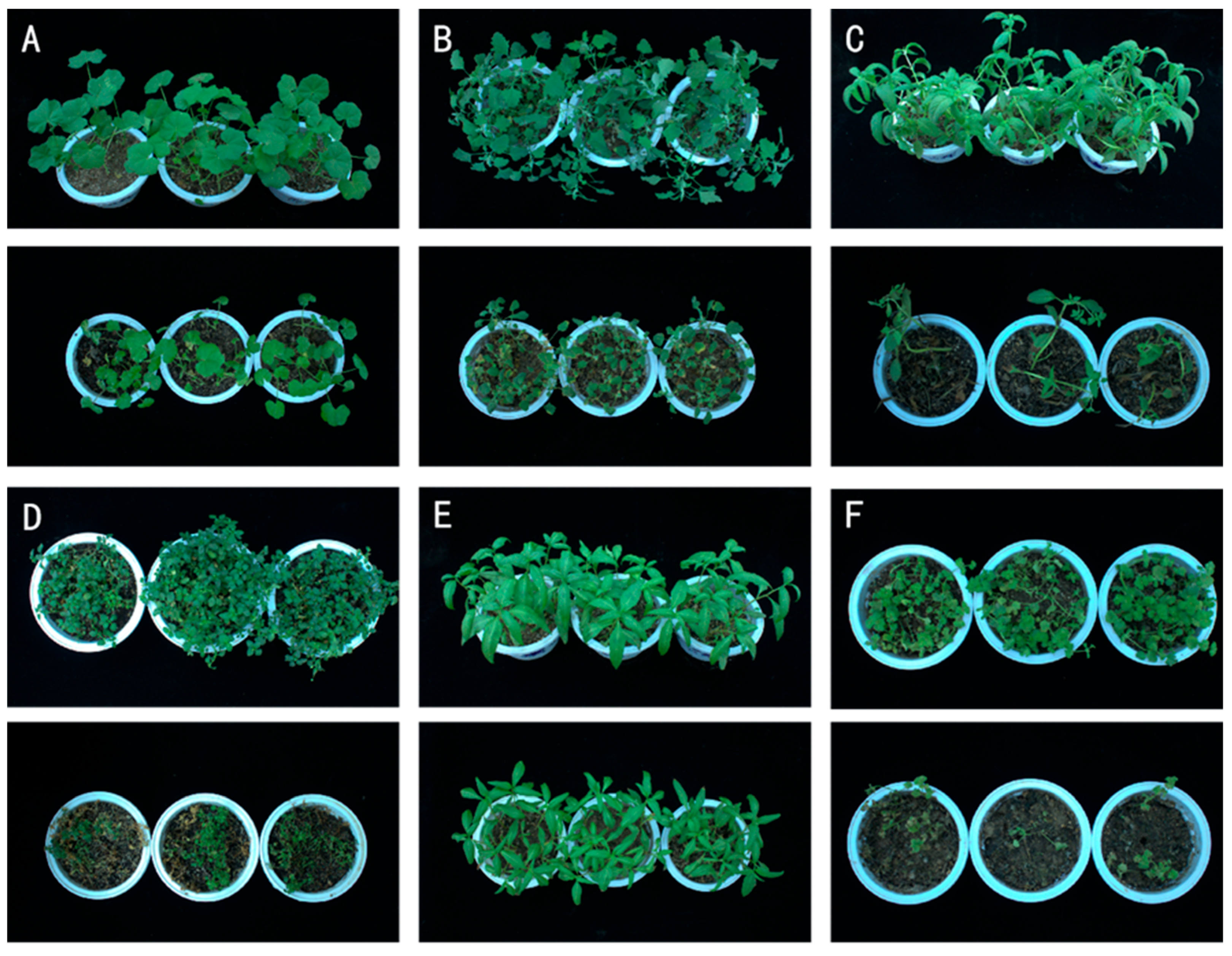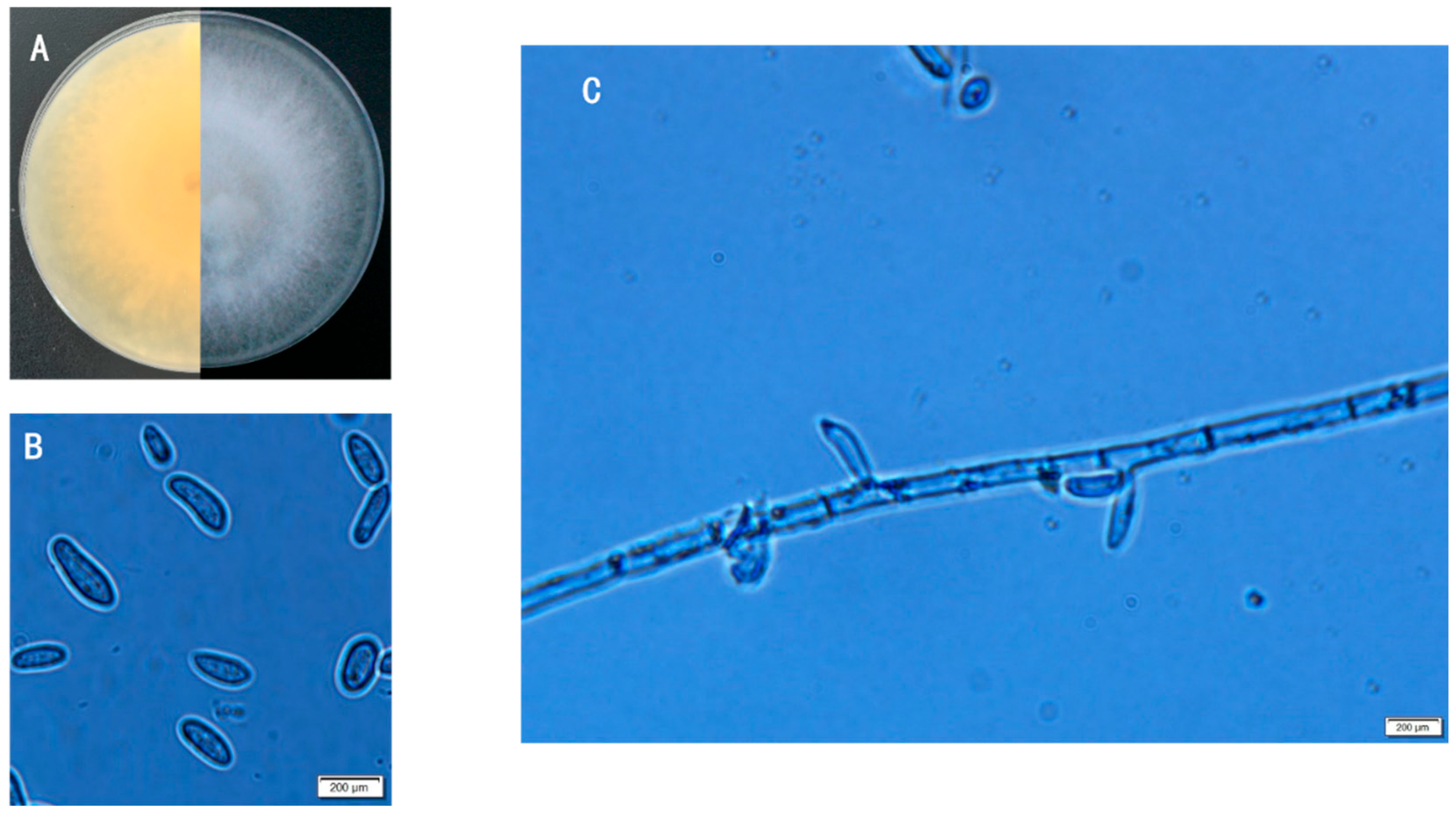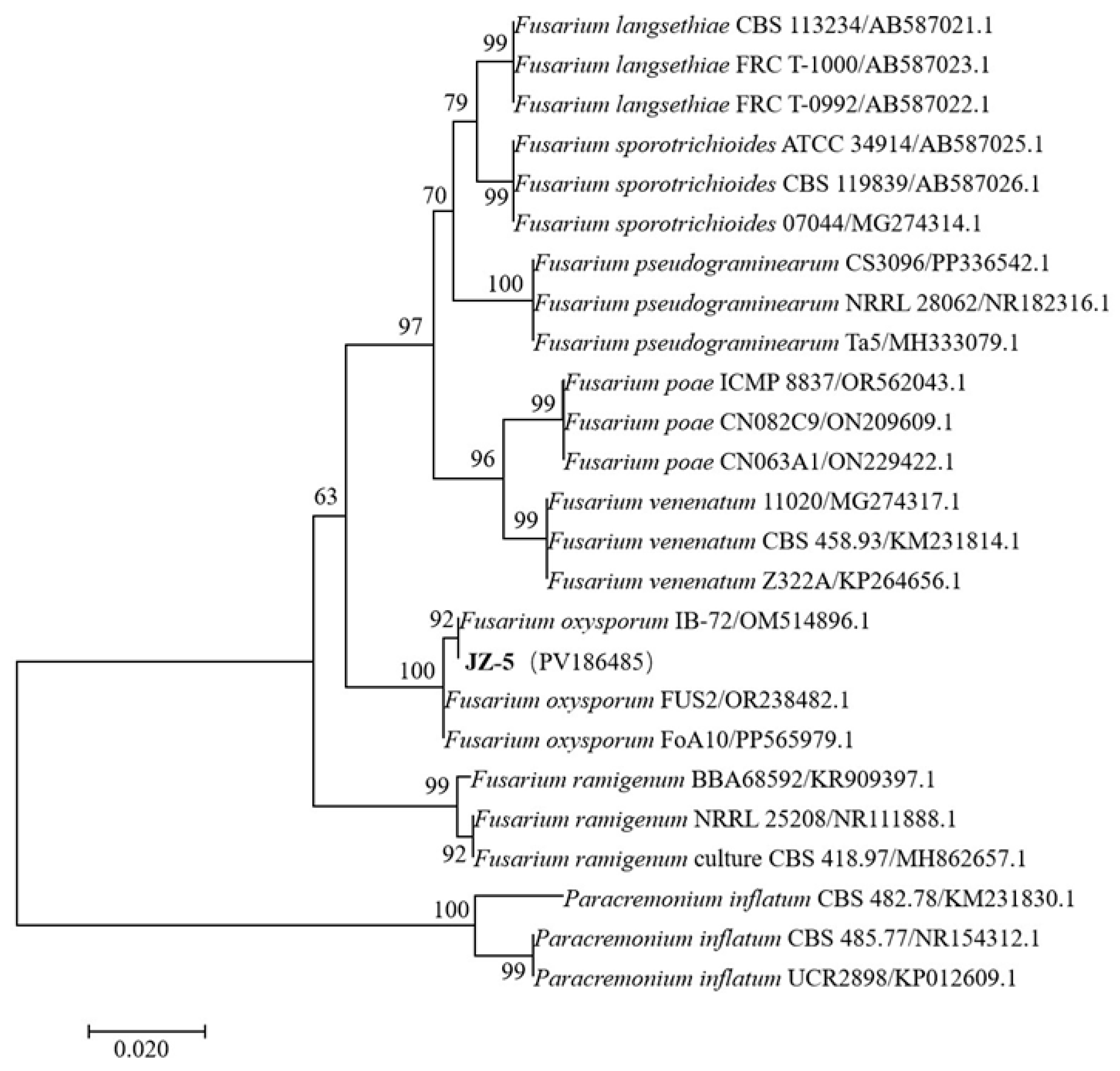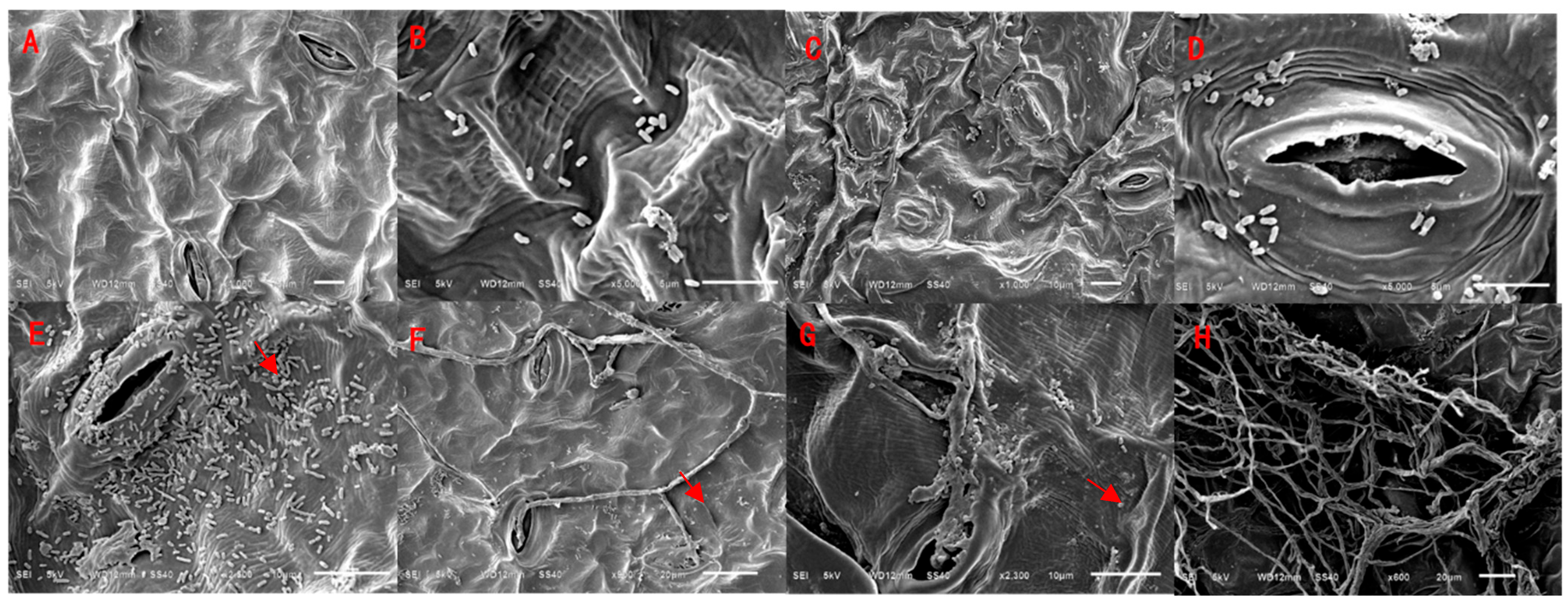Study of the Herbicidal Potential and Infestation Mechanism of Fusarium oxysporum JZ-5 on Six Broadleaved Weeds
Abstract
1. Introduction
2. Materials and Methods
2.1. Survey Locations and Sampling
2.2. Isolation of the Pathogen
2.3. In Vitro Pathogenicity Assay of Strain JZ-5 on Leaf Segments of Four Weed Species
2.4. Pathogenicity Assessment of Strain JZ-5 on Six Weed Species
2.5. Safety Evaluation of Strain JZ-5 on Six Crop Species
2.6. Molecular Identification and Characterization of Target Strain
2.6.1. Identification Based on Morphological Characteristics
2.6.2. Molecular Identification
2.7. Ation of Strain JZ-5 for Electron Microscopy Observation on Malva verticillata L. (Cluster Mallow)
2.8. Data Processing
3. Results
3.1. Pathogenicity Assay of Strain JZ-5 Spore Suspension on Detached Leaves of Four Weed Species
3.2. Pathogenicity Assay of Strain JZ-5 Spore Suspension on Six Potcultured Weed Species
3.3. Safety Evaluation of Strain JZ-5 Spore Suspension on Four Crop Species
3.4. Identification of the Strains
3.4.1. Morphological Characterization of Strain JZ-5
3.4.2. Molecular Characterization of Fusarium oxysporum Strain JZ-5
3.4.3. Observations on the Pathogenic Process of Strain JZ-05 on the Leaves of Winter Anemone Weeds
4. Discussion
5. Conclusions
Author Contributions
Funding
Institutional Review Board Statement
Informed Consent Statement
Data Availability Statement
Conflicts of Interest
References
- Song, W.M. Weed Community Composition and Control Strategies in Oat Fields of Qinghai. Master’s Thesis, Qinghai University, Xining, China, 2022. [Google Scholar] [CrossRef]
- Suo, D.Z.; Zhang, R.J.; Tong, L.J. Thoughts on Ecological Protection and High-Quality Development in the Source Region of the Yellow River. Qinghai Soc. Sci. 2022, 43–52. Available online: http://www.qhass.org.cn/upload/20240109/a2811a10012ff7451e60b50d7aeaee.pdf (accessed on 3 June 2025).
- Huang, Y.; Wu, D.; Huang, Z.; Li, X.; Merotto, A.; Bai, L.; Fan, L. weed genomics yie1ding insights into the genetics of weedy traits for crop improvement. aBIOTECH 2023, 4, 20–30. [Google Scholar] [CrossRef] [PubMed]
- Horvath, D.P.; Clay, S.A.; Swanton, C.J.; Anderson, J.V.; Chao, W.S. Weed-induced crop yield loss: A new paradigm and new challenges. Trends Plant Sci. 2023, 28, 567–582. [Google Scholar] [CrossRef]
- Oerke, E.-C. Crop losses to pests. J. Agric. Sci. 2006, 144, 31–43. [Google Scholar] [CrossRef]
- Menalled, U.D.; Smith, R.G.; Cordeau, S.; DiTommaso, A.; Pethybridge, S.J.; Ryan, M.R. Phylogenetic relatedness can influence cover crop-based weed suppression. Sci. Rep. 2023, 13, 17323. [Google Scholar] [CrossRef]
- Yang, L.; Li, H.; Zhang, Y.; Jiao, N. Environmental risk assessment of triazine herbicides in the Bohai Sea and the Yellow Sea and their toxicity to phytoplankton at environmental concentrations—ScienceDirect. Environ. Int. 2019, 133 Pt A, 105175. [Google Scholar] [CrossRef]
- Li, J.; Li, M.; Gao, X.; Fang, F.; Dong, L. Research advances and prospects of microbial herbicides. Shandong Agric. Sci. 2016, 48, 149–156. [Google Scholar]
- Ņečajeva, J.; Borodušķe, A.; Nikolajeva, V.; Seņkovs, M.; Kalniņa, I.; Roga, A.; Skinderskis, E.; Fridmanis, D. Epiphytic and endophytic fungi colonizing seeds of two Poaceae weed species and Fusarium spp. seed degradation potential in vitro. Microorganisms 2023, 11, 184. [Google Scholar] [CrossRef]
- Motlagh, M.R.S. Study of Fusarium equiseti, as bicontrol agent of Echinochloa oryzicola in paddy fields. J. Pure. Appl. Microbiol. 2014, 8, 1259–1264. [Google Scholar]
- Lewis, R.W.; Okubara, P.A.; Sullivan, T.S.; Madden, B.J.; Johnson, K.L.; Charlesworth, M.C.; Fuerst, E.P. Proteome-Wide Response of Dormant Caryopses of the Weed, Avena fatua, After Colonization by a Seed-Decay Isolate of Fusarium avenaceum. Phytopathology 2022, 112, 1103–1117. [Google Scholar] [CrossRef]
- De Luna, L.Z.; Kennedy, A.C.; Hansen, J.C.; Paulitz, T.C.; Gallagher, R.S.; Fuerst, E.P. Mycobiota on Wild Oat (Avena fatua L.) Seed and Their Caryopsis Decay Potential. Plant Health Prog. 2011, 12, 20. [Google Scholar] [CrossRef]
- Ma, Y.; Ke, Y.; Wang, Q.; Li, B.; Li, Y. Symptoms and pathogen identification of walnut canker disease. J. Fruit Sci. 2014, 31, 443–447+525. [Google Scholar]
- Qiong, H. Potential Evaluation and Host Range Testing of Bio-control Fungi for Microstegium vimineum. Master’s Thesis, Nanjing Agricultural University, Nanjing, China, 2017. [Google Scholar] [CrossRef]
- Zhu, H.; Lin, Z.; Ma, Y. Evaluation of the biocontrol potential of the fungus Botrytis euroamericana strain HZ-011 for herbicidal activity. Egypt. J. Biol. Pest Control. 2023, 33, 51. [Google Scholar] [CrossRef]
- Wei, J.C. Handbook for Fungi Identification; Science and Technology Press: Shanghai, China, 1979; pp. 141–159. [Google Scholar]
- Li, D.Y. Preparation of Compound Microbial Agents and Their Application in Weed Control in Wheat Fields. Master’s Thesis, University of Science and Technology Liaoning, Anshan, China, 2021. [Google Scholar] [CrossRef]
- Triolet, M.; Guillemin, J.-P.; Andre, O.; Steinberg, C.; Hatcher, P. Fungal-based bioherbicides for weed control: A myth or a reality? Weed Res. 2020, 60, 60–77. [Google Scholar] [CrossRef]
- Jiang, Y.; Wang, J. The Registration Situation and Use of Mycopesticides in the World. J. Fungi 2023, 9, 940. [Google Scholar] [CrossRef]
- Khan, M.F.; Ali, S.; Rizvi, Z. Pathogenicity of Fusarium species and their role in major crop diseases: A review. Plant Dis. 2021, 105, 1044–1054. [Google Scholar]
- Pearson, K.A.; Taylor, A.F.S.; Fuchs, R.M.E.; Woodward, S. Characterisation and pathogenicity of Fusarium taxa isolated from ragwort (Jacobaea vulgaris) roots. Fungal Ecol. 2016, 20, 186–192. [Google Scholar] [CrossRef]
- Hasan, M.; Ahmad-Hamdani, M.S.; Rosli, A.M.; Hamdan, H. Bioherbicides: An eco-friendly tool for sustainable weed management. Plants 2021, 10, 1212. [Google Scholar] [CrossRef] [PubMed]
- Todero, I.; Confortin, T.C.; Luft, L.; Seibel, J.; Kuhn, R.C.; Tres, M.V.; Zabot, G.L.; Mazutti, M.A. Concentration of exopolysaccharides produced by Fusarium fujikuroi and application of bioproduct as an effective bioherbicide. Environ. Technol. 2019, 41, 21. [Google Scholar] [CrossRef]
- Neto, J.R.C.; dos Santos, M.S.N.; Mazutti, M.A.; Zabot, G.L.; Tres, M.V. Phoma dimorpha phytotoxic activity potentialization for bioherbicide production. Biocatal. Agric. Biotechnol. 2021, 33, 101986. [Google Scholar] [CrossRef]
- Abbas, T.; Zahir, Z.A.; Naveed, M.; Kremer, R.J. Limitations of Existing Weed Control Practices Necessitate Development of Alternative Techniques Based on Biological Approaches. Adv. Agron. 2018, 147, 239–280. [Google Scholar] [CrossRef]
- Bo, A.B.; Kim, J.D.; Kim, Y.S.; Sin, H.T.; Kim, H.J.; Khaitov, B.; Ko, Y.K.; Park, K.W.; Choi, J.S.; Bajpai, V.K. Isolation, identification and characterization of Streptomyces metabolites as a potential bioherbicide. PLoS ONE 2019, 14, e0222933. [Google Scholar] [CrossRef] [PubMed]
- Desjardins, A.E.; Proctor, R.H. Molecular biology of Fusarium mycotoxins. Int. J. Food Microbiol. 2007, 119, 47–50. [Google Scholar] [CrossRef]
- Kołodziejczyk, M. The effect of living mulches and conventional methods of weed control on weed infestation and potato yield. Sci. Hortic. 2015, 191, 127–133. [Google Scholar] [CrossRef]
- Daniel, J.J.; Brun, T.; Todero, I. Association of Adjuvants with Culture Filtrate from Fusarium fujikuroi for Increasing the Control of Conyza sp. Biointerface Res. Appl. Chem. 2020, 10, 6481–6487. [Google Scholar]
- Loomans, A.J. Every generalist biological control agent requires a special risk assessment. BioControl 2021, 66, 23–35. [Google Scholar] [CrossRef]
- Cheng, H.; Li, J.; Zhu, H.; Wei, Y.; Wang, X.; Cheng, L. Herbicidal activity and crop safety of Alternaria alternata DT-XRKA and Fusarium avenaceum DT-QKBD004A. Sci. Rep. 2025, 15, 9933. [Google Scholar] [CrossRef]
- Mendgen, K.; Hahn, M. Review: Plant infection and the establishment of fungal biotrophy. Trends Plant Sci. 2002, 7, 352–356. [Google Scholar] [CrossRef]
- Marinho, G.; Barbosa, B.C.A.; Rodrigues, K.; Aquino, M.; Pereira, L. Potential of the filamentous fungus Aspergillus niger AN400 to degrade Atrazine in wastewaters. Biocatal. Agric. Biotechnol. 2017, 9, 162–167. [Google Scholar] [CrossRef]
- Li, Y.; Sun, Z.; Zhuang, X.; Xu, L.; Chen, S.; Li, M. Research progress on microbial herbicides. Crop Prot. 2003, 22, 247–252. [Google Scholar] [CrossRef]
- He, Y.S.; Zhu, H.X. Preliminary study on the weed control mechanism of Alternaria gaisen GD-011. Zhejiang J. Agric. 2024, 36, 1094–1101. [Google Scholar]
- Xu, Y.Y.; Luo, G.M.; Luo, Y.J.; Liu, P.P.; Wang, E.Y.; Chen, Y.T.; Zhou, L. Scanning electron microscopic observation of Glomerella septospora infested leaves of Gardenia jasminoides. J. Electron Microsc. 2021, 40, 441–445. [Google Scholar]
- Lüth, P.; Nzioki, H.S.; Baker, C.S.; Sands, D.C. A microbial bioherbicide for Striga hermonthica control: Production, development, and effectiveness of a seed coating agent. Pest Manag. Sci. 2024, 80, 149–155. [Google Scholar] [CrossRef] [PubMed]
- Morin, L. Progress in Biological Control of Weeds with Plant Pathogens. Annu. Rev. Phytopathol. 2020, 58, 201–223. [Google Scholar] [CrossRef]






| Weed | Blade Area (cm2) | Incidence Area (cm2) | Incidence Grade | Incidence Characteristics |
|---|---|---|---|---|
| Malva verticillata L. | 11.38 ± 1.30 a | 11.08 ± 1.33 a | 4 | Leaf blade yellowing and softening, surface distribution of a large amount of mycelium, brownish and dead |
| Polygonum lapathifolium L. | 7.84 ± 2.20 b | 7.20 ± 2.53 b | 4 | Small brown spots around the fungus cake, leaf margins wrinkled and curled |
| Polygonum aviculare L. | 1.79 ± 0.35 c | 1.05 ± 0.13 c | 2 | Leaf discoloration and yellowing, mycelia cover the leaves |
| Lamiuma mplexicaule L. | 3.16 ± 0.05 c | 2.81 ± 0.61 c | 4 | Leaf blade turned completely yellow-brown, mycelium covers the whole leaf blade |
| Weed | Morbidity Rate(%) | Disease Index | Incidence Grade |
|---|---|---|---|
| Malva verticillata L. | 33.61 ± 3.75 b | 8.36 ± 0.90 c | 1 |
| Chenopodium album L. | 76.83 ± 1.78 a | 38.36 ± 0.85 b | 3 |
| Elsholtzia densa Benth. | 81.71 ± 1.66 a | 61.26 ± 1.25 a | 3 |
| Stellaria media (L.) Vill. | 75.17 ± 2.52 a | 62.60 ± 10.90 a | 3 |
| Polygonum lapathifolium L. | 23.46 ± 6.00 c | 5.83 ± 1.52 c | 1 |
| Lamium amplexicaule L. | 86.25 ± 5.43 a | 64.63 ± 4.09 a | 3 |
| Crop | Morbidity Rate (%) | Disease Index (%) | Incidence Grade | Safety Grade |
|---|---|---|---|---|
| Hordeum vulgare var. nudum | 0.00 | 0.00 | 0 | NS |
| Triticum aestivum L. | 0.00 | 0.00 | 0 | NS |
| Solanum tuberosum L. | 0.00 | 0.00 | 0 | NS |
| Brassica napus L. | 3.33 | 0.67 | 1 | LS |
| Pisum sativum L. | 6.25 | 1.25 | 1 | LS |
| Vicia faba L. | 10 | 2 | 1 | LS |
Disclaimer/Publisher’s Note: The statements, opinions and data contained in all publications are solely those of the individual author(s) and contributor(s) and not of MDPI and/or the editor(s). MDPI and/or the editor(s) disclaim responsibility for any injury to people or property resulting from any ideas, methods, instructions or products referred to in the content. |
© 2025 by the authors. Licensee MDPI, Basel, Switzerland. This article is an open access article distributed under the terms and conditions of the Creative Commons Attribution (CC BY) license (https://creativecommons.org/licenses/by/4.0/).
Share and Cite
Zhang, S.; Zhu, H.; Ma, Y.; Cheng, L. Study of the Herbicidal Potential and Infestation Mechanism of Fusarium oxysporum JZ-5 on Six Broadleaved Weeds. Microorganisms 2025, 13, 1541. https://doi.org/10.3390/microorganisms13071541
Zhang S, Zhu H, Ma Y, Cheng L. Study of the Herbicidal Potential and Infestation Mechanism of Fusarium oxysporum JZ-5 on Six Broadleaved Weeds. Microorganisms. 2025; 13(7):1541. https://doi.org/10.3390/microorganisms13071541
Chicago/Turabian StyleZhang, Suifang, Haixia Zhu, Yongqiang Ma, and Liang Cheng. 2025. "Study of the Herbicidal Potential and Infestation Mechanism of Fusarium oxysporum JZ-5 on Six Broadleaved Weeds" Microorganisms 13, no. 7: 1541. https://doi.org/10.3390/microorganisms13071541
APA StyleZhang, S., Zhu, H., Ma, Y., & Cheng, L. (2025). Study of the Herbicidal Potential and Infestation Mechanism of Fusarium oxysporum JZ-5 on Six Broadleaved Weeds. Microorganisms, 13(7), 1541. https://doi.org/10.3390/microorganisms13071541






